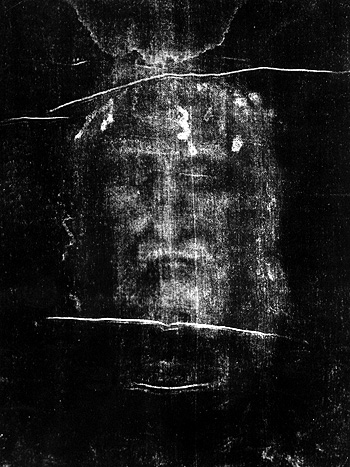SHROUD SERIES, Part 5:
The Spiritual Message of the
Shroud
continued from Part
4....
by Fr. Hilary Conti, O.S.B.

A Benedictine
monk from England, who had been eating and listening very carefully without
saying one word, broke in: “Yes, I agree with you. It is time
to explore the spiritual message of the Holy Shroud. Did you ever
notice that the impression of the Body of Christ on the Shroud is the most
graphic description of the Sacrifice of the Holy Eucharist? No words,
no books, no picture can explain the unbloody Sacrifice of Christ as the
Holy Shroud does. Lucia, one of the three seers of the apparition
at Fatima, testified that in 1916 an angel appeared to them, holding in
his hand a chalice, and above the chalice a host from which a few drops
of blood were falling. Leaving the chalice and host suspended in
air, he prostrated himself on the ground and said, ‘O most Holy Trinity
....I offer Thee the most precious Body and Blood of Jesus Christ....’
Because of that vision I find myself during the Mass visualizing the Shroud
and all the suffering of Jesus, and offering to God the Host and the suffering
of Jesus for myself and for sinners. The Sacrifice of the Holy Eucharist
is a memorial and repetition of the Passion and Death of Christ and this
mystery becomes more real to us if we associate it with the Holy Shroud.”
The
guest next to me, one of our monks in Italy, loved the idea of associating
the Holy Eucharist with the Holy Shroud and so he added, “...what you say,
Father, is beautiful and there is much history for it. I read an
article in the Catholic Encyclopedia on the word ‘corporal’ and as surprising
as it may seem, the coporal and the pall are substitutes for the Holy Shroud.
According to the article there are traditions in the Church stating that
the Apostles themselves in repeating the Lord’s Supper may have actually
used the Holy Shroud to cover the table. After the words of consecration,
they covered the bread and the cup with the Shroud as a remembrance of
Jesus wrapped in the Shroud. Eventually they made substitutes for
the Shroud and these were called palla corporalis (mantle of the body).
Such ritualistic custom continued for centuries. In our monastery
of St. Sylvester (Italy) in the fourteenth century we find a rubric directing
the deacon with the help of the subdeacon of cover the consecrated bread
and chalice with the palla corporalis. Obviously it was one single
piece of altar cloth, long enough to require the help of the subdeacon.
Eventually it became smaller yet, and further on it has been cut into two
parts: one half to cover the chalice, called the “pall”, and the
second half, called “corporal’, laid on the altar to place on it the host
and chalice. Therefore your suggestion of associating the Holy Eucharist
with the Holy Shroud is theologically sound and well founded in the traditions
of the Church.”
At table
there was a lady from Brooklyn and she also had some experience to tell
us. “I am a nurse in a hospital and many times I have wrapped dead
persons in a shroud and put them away. Every time I do it, it brings
tears to my eyes. That is the duty we nurses dread doing most.
I know nurses who will definitely look for any excuse to avoid it.
Because of this experience, when today I saw the Holy Shroud over the altar,
I could visualize the sorrow on the face of the Blessed Mother as she helped
wrap Jesus in that shroud, leaving Him alone in the sepulcher, and walking
home without Him.
